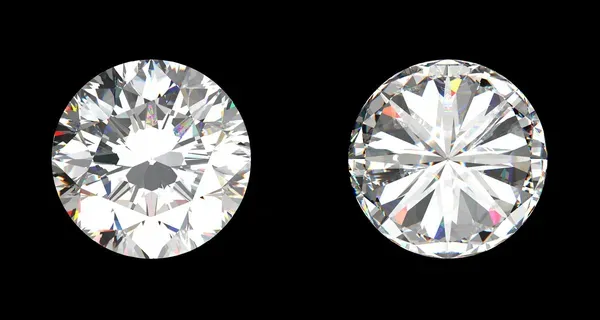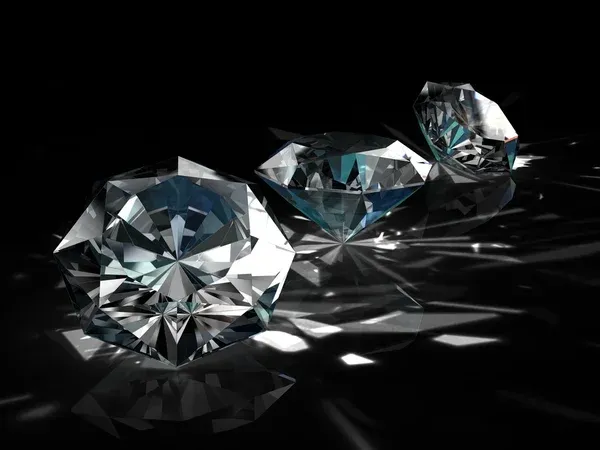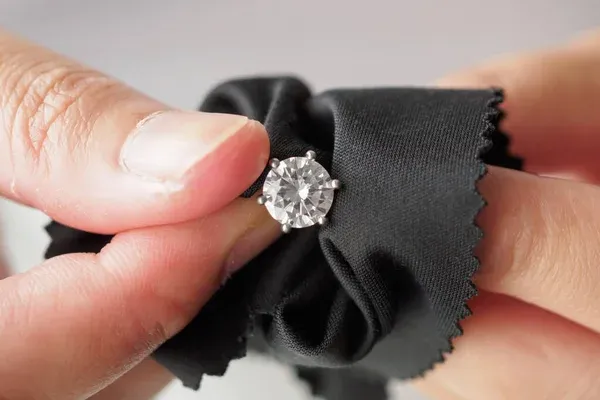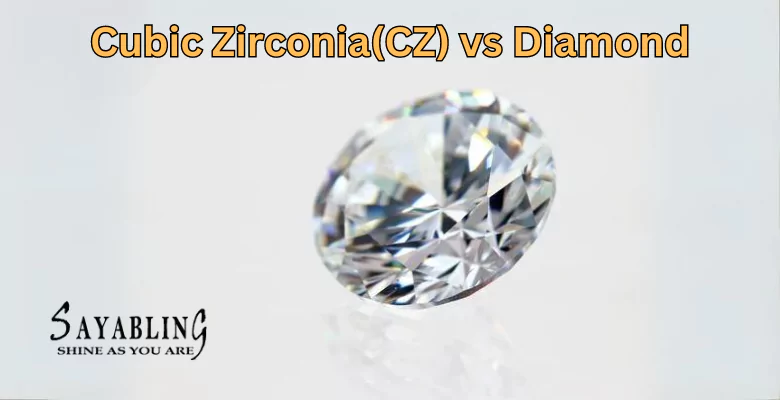Cubic Zirconia (CZ) and diamonds are often compared due to their similar appearance, but they differ significantly in composition, properties, and value. Cubic Zirconia (CZ) is a synthetic, affordable alternative to diamonds, offering brilliance and clarity but lacking the hardness and long-term durability of diamonds.
CZ sparkles more but can look artificial, and it’s more prone to scratches and dulling over time, whereas diamonds are extremely hard, long-lasting, and maintain their brilliance. In contrast, CZ is a budget-friendly option, diamonds whether natural or lab-created are made entirely from carbon element (C) and cubic zirconia is composed of a composite substance known as zirconium dioxide (ZrO2).
Cubic zirconia is mostly man-made and has a cubic crystalline form similar to natural diamonds, but the similarities end there.
Cubic Zirconia (CZ) vs Diamonds

Here’s a breakdown of the key differences between CZ and diamonds, along with some factors to consider when deciding which one is better for you.
Composition and Origin
| Cubic Zirconia | Diamonds |
|---|---|
| CZ is a synthetic gemstone made from zirconium dioxide. It is entirely man-made and is produced in laboratories. | Diamonds are made of pure carbon that has been subjected to high pressure and heat over millions of years. They can be natural (mined) or lab-created (using a process similar to the one that forms diamonds in nature). |
Hardness and Durability
| Cubic Zirconia | Diamonds |
|---|---|
| CZ is softer than a diamond, with a rating of 8-8.5 on the Mohs scale of hardness. It is durable for daily wear but is more prone to scratching and dulling over time. | Diamonds are the hardest known material, with a perfect score of 10 on the Mohs scale. They are highly resistant to scratches and last much longer in terms of brilliance and durability. |
Brilliance and Sparkle
| Cubic Zirconia | Diamonds |
|---|---|
| CZ has a higher dispersion rate (0.060) than diamonds, which means it reflects more rainbow-colored light, often appearing “flashier.” However, its sparkle can look more artificial to some due to its excess brilliance. | Diamonds have a slightly lower dispersion rate (0.044) but exhibit a unique brilliance due to their refractive index and excellent light performance. They sparkle in a way that’s considered more natural and “fire-like.” |
Clarity and Color
| Cubic Zirconia | Diamonds |
|---|---|
| Cubic zirconia is typically flawless, meaning it doesn’t have inclusions or imperfections that natural diamonds may have. | Diamonds can have natural inclusions and blemishes, and their clarity is graded on a scale. Flawless diamonds are rare and expensive. Similarly, diamonds come in different color grades, ranging from colorless to slightly yellow or brown. |
Weight
| Cubic Zirconia | Diamonds |
|---|---|
| CZ is denser than diamonds, so a CZ of the same size will be heavier. | Diamonds are lighter, and their value is heavily influenced by carat weight. |
Price
| Cubic Zirconia | Diamonds |
|---|---|
| CZ is significantly more affordable than diamonds. You can get a larger CZ stone for a fraction of the price of a small diamond. | Diamonds are much more expensive, with prices varying greatly depending on size, quality (the 4Cs: cut, clarity, color, and carat), and whether they are natural or lab-grown. |
Longevity
| Cubic Zirconia | Diamonds |
|---|---|
| Over time, CZ can lose its brilliance, becoming cloudy and scratched. While it’s great for short-term use, it may not hold up as well for a lifetime. | Diamonds are forever, literally. They retain their sparkle and are resistant to wear, making them ideal for heirloom or long-lasting jewelry. |
Symbolism and Value
| Cubic Zirconia | Diamonds |
|---|---|
| CZ does not have the same symbolic value as diamonds, which are traditionally associated with love, commitment, and luxury. | Diamonds are often seen as symbols of eternal love and status. They are a traditional choice for engagement rings and hold significant resale value. |
Which One is Better CZ or Diamonds?
It depends on what you’re looking for:
- Budget-Friendly: If you want a beautiful, affordable stone that mimics a diamond’s appearance, Cubic Zirconia is a great choice.
- Longevity and Symbolism: If you want a durable, prestigious stone with lasting brilliance and significant meaning, diamonds (natural or lab-created) are better.
Ultimately, the decision depends on personal preferences, budget, and the purpose of the jewelry.
How are Lab-Created Diamonds Different From Cubic Zirconia?

It’s important to note that cubic zirconia stones are synthetic and are not the same as lab-created diamonds. Cubic zirconia stones are diamond stimulants, while lab-created diamonds are synthetic diamonds with carbon atom structures similar to natural diamonds.
They are grown under conditions that mimic those required for natural diamonds, resulting in optical and physical characteristics similar to natural diamonds but if you are more concerned about what-is-the-difference-between-lab-grown-and-natural-diamonds?
Lab-created diamonds are real diamonds and possess all the characteristics of natural diamonds, such as signature white brilliance and incredible durability. Despite being cheaper than natural diamonds, they are still a fraction of the market rate for similar carat size and quality.
In comparison, cubic zirconia is much cheaper but may require replacement in the future due to sustaining more damage and losing reflectivity. Many buyers still prefer to purchase natural or lab-grown diamonds as they offer better value in terms of quality and longevity.
Lab-grown diamonds are tough to differentiate from natural diamonds and are available in various hues, including white, colorless, pink, yellow, orange, and blue, as well as different levels of clarity and cut. Cubic zirconia stones do not have the same chemical composition, brilliance, or reflective properties as lab-grown diamonds, and are not as unique due to their flawless, specific heat conditions.
Both cubic zirconia and lab-grown diamonds are more affordable than natural diamonds and can be insured, although the value will differ significantly between the two types of gemstones.
Is a Cubic Zirconia Real?
A cubic zirconia is a real cubic zirconia, but it is not a real diamond. However, there are a few types of stones that are used as diamond simulants, and cubic zirconia is by far the most common and the most realistic.
How to Take Care of Cubic Zirconia

Taking care of cubic zirconia (CZ) jewelry is essential to maintaining its brilliance and extending its lifespan. Here are some tips to keep CZ stones sparkling and looking their best:
- Clean CZ jewelry regularly to remove dirt, oils, and residue. Use warm water, a mild dish soap, and a soft toothbrush to gently scrub the stone. Rinse thoroughly and pat dry with a soft cloth.
- Keep CZ away from harsh chemicals, such as household cleaners, chlorine, and perfumes, which can dull its sparkle or damage the setting.
- Store your CZ jewelry separately from other pieces to prevent scratches. Use a soft pouch or jewelry box with separate compartments.
- Prolonged exposure to heat or direct sunlight can cause CZ stones to become cloudy over time. Store them in a cool, dry place when not in use.
- Take off CZ jewelry when doing physical activities, such as exercising, swimming, or cleaning, to prevent scratches or damage.
Conclusion
Diamonds are a better choice than cubic zirconia but Cubic Zirconia (CZ) provides a cost-effective and stunning alternative to diamonds, although it may not match the long-lasting durability and status of diamonds. CZ is more delicate and susceptible to scratches, but with proper care, such as regular cleaning, avoiding harsh chemicals, and careful storage, it can retain its sparkle over time.
While diamonds are more resilient, carry symbolic significance, and are ideal for long-term wear, CZ jewelry is perfect for those looking for affordable, attention-grabbing jewelry. Ultimately, the decision CZ vs diamonds depends on your budget, preferences, and how long you intend to keep the piece.
FAQ’s
What is cubic zirconia?
Cubic zirconia (CZ) is a mineral that closely resembles a diamond but is made from zirconium dioxide (ZrO2), unlike diamonds, which are pure carbon. While CZ can occur naturally, most CZ used in jewelry is lab-made. Its name comes from its cubic crystalline structure, similar to that of a diamond, but the similarities between the two stones end there.CZ are colorless gemstones but Most CZs are clear or white and this natural colorlessness allows manufacturers to color them with coloring agents.
how can you tell the difference between diamond and cubic zirconia?
When determining if a gem is a cubic zirconia or a real diamond, look for wear, color, and facet edges. Diamonds are harder and won’t scratch easily. Examine the facet edges with a magnifying glass, diamond’s facet edges will usually look incredibly sharp and precise. Also, observe the color of light entering and escaping the stone. Diamonds reflect the entire rainbow, while CZs show orange and blue flashes due to different refractive indexes.
how long does cz last?
Cubic zirconia is much less durable than a genuine diamond. They can be worn daily for 2 to 3 years, or up to 5 years if worn occasionally. As cubic zirconia stones age, they are prone to getting scratched and looking cloudy. Exposure to dirt, oxygen, chlorine, and water will accelerate the aging process and increase the likelihood of damaging the stone.
